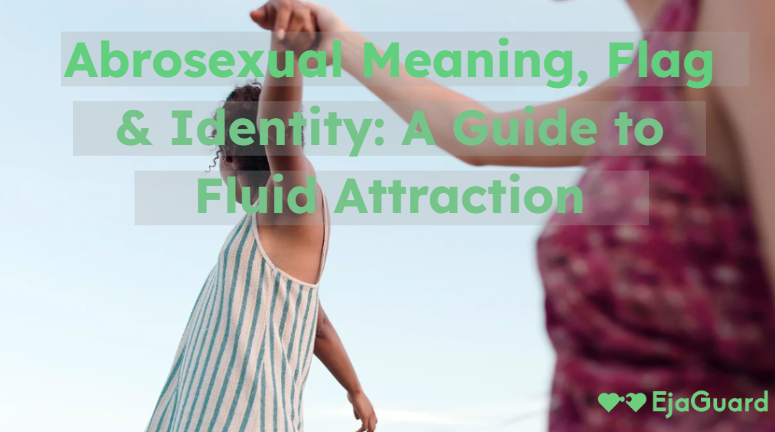Abrosexuelle Bedeutung, Flagge und Identität: Ein Leitfaden zur fließenden Anziehung
Einführung
Sexualität ist vielfältig, und viele Identitäten fallen in das LGBTQ+-Spektrum. Eine weniger bekannte, aber wichtige Identität ist die Abrosexualität. Der Begriff Abrosexualität bezieht sich auf Personen, deren sexuelle Anziehungskraft sich im Laufe der Zeit verändert. Das bedeutet, dass sie an einem Tag sexuelle Anziehung verspüren, am nächsten aber nicht, oder dass ihre romantischen und sexuellen Interessen zwischen den Geschlechtern wechseln.
Dieser Artikel untersucht die Bedeutung von „abrosexuell“, ihre Beziehung zur Geschlechtsidentität und sexuellen Orientierung, die „abrosexuelle Flagge“ und wie abrosexuelle Menschen mit ihren Erfahrungen umgehen.

Möchten Sie mehr über sexuelle Orientierungen erfahren? Besuchen Sie den Blog von EjaGuard für Bildungsressourcen und Einblicke zu LGBTQ+-Identitäten.
Was bedeutet abrosexuell?
Der Begriff „abrosexuell“ leitet sich vom griechischen Wort „abro“ ab, was zart oder anmutig bedeutet. Abrosexualität bezeichnet eine fließende sexuelle Orientierung, d. h. die Anziehungskraft einer Person kann in Intensität und Richtung schwanken.
Einige wichtige Punkte zu abrosexuellen Menschen:
- Sie können sich zu unterschiedlichen Zeiten zu unterschiedlichen Geschlechtern hingezogen fühlen.
- Ihr sexuelles Verlangen kann sich häufig oder über längere Zeiträume ändern.
- Manche empfinden möglicherweise nur gelegentlich sexuelle Anziehung, während bei anderen die Wechselwirkungen häufiger sind.
- Abrosexualität ist nicht dasselbe wie Asexualität, es kann jedoch Überschneidungen geben.
- Für diejenigen, die eine fließende Sexualität erforschen, kann das Verständnis der eigenen Wünsche der Schlüssel zur Selbstakzeptanz sein. Steigern Sie Intimität und Vergnügen mit den Gleitmitteln von EjaGuard , die auf Komfort und Anpassungsfähigkeit ausgelegt sind.
Abrosexuell vs. sexuell fluid: Was ist der Unterschied?
Obwohl sowohl Abrosexualität als auch sexuelle Fluidität mit Veränderungen der Anziehung einhergehen, unterscheiden sie sich:
- Abrosexualität beschreibt eine schwankende sexuelle Anziehung, die auch Phasen umfassen kann, in denen überhaupt keine Anziehung empfunden wird.
- Sexuelle Fluidität bezieht sich auf eine allgemeine Offenheit für wechselnde Anziehungskräfte, bedeutet aber nicht unbedingt häufige Wechsel.
Abrosexualität vs. Asexualität: Wichtige Unterschiede
Eine häufig gestellte Frage lautet: Ist Abrosexualität dasselbe wie Asexualität? Die Antwort lautet nein.
- Asexuelle Menschen verspüren normalerweise keine oder nur sehr selten sexuelle Anziehung.
- Asexuelle Menschen empfinden Anziehung, aber Intensität, Häufigkeit und Geschlechtspräferenz können variieren.
- Manche abrosexuellen Personen identifizieren sich manchmal als asexuell, je nachdem, wie stark ihre Anziehung schwankt.
-
Wussten Sie schon? Studien zeigen, dass die sexuelle Anziehung durch verschiedene biologische und psychologische Faktoren beeinflusst werden kann. Lesen Sie hier mehr darüber .
Die abrosexuelle Flagge und ihre Bedeutung

Wie andere Identitäten hat auch die Abrosexualität eine Flagge, die die Gemeinschaft repräsentiert.
Farben und Symbolik der asexuellen Flagge:
- Rosa: Steht für die Anziehungskraft der Weiblichkeit.
- Grün: Steht für die Anziehungskraft der Männlichkeit.
- Weiß: Symbolisiert Veränderungen in Anziehung und Flüssigkeit.
- Hellgrün und Hellrosa: Repräsentieren die zarte, anmutige Natur der Abrosexualität.
Diese Flagge hebt die fließende sexuelle Orientierung asexueller Personen hervor und bietet denjenigen Sichtbarkeit, die sich damit identifizieren.
Möchten Sie Ihre Identität selbstbewusst zum Ausdruck bringen? Entdecken Sie die LGBTQ+-inklusive Dessous-Kollektion von EjaGuard und betonen Sie Ihre Einzigartigkeit.
Abrosexualität und Geschlechtsidentität
Obwohl Abrosexualität eine sexuelle Identität ist, unterscheidet sie sich von der Geschlechtsidentität. Manche Abrosexuellen identifizieren sich jedoch auch als genderfluid, nicht-binär oder transgender.
Hauptunterschiede:
- Die sexuelle Identität bezieht sich darauf, zu wem Sie sich hingezogen fühlen.
- Die Geschlechtsidentität bezieht sich darauf, wie Sie sich selbst wahrnehmen.
Da es sich bei der Abrosexualität um eine sexuelle Fluidität handelt, kann es bei manchen Menschen auch zu Veränderungen der Geschlechtsidentität kommen, dies ist jedoch keine Voraussetzung.
Das Verständnis Ihres Geschlechts und Ihrer Sexualität ist eine Reise. Erfahren Sie mehr über die Selbsterforschung im Blog von EjaGuard .

Wie abrosexuelle Menschen Anziehung erfahren
Da es sich bei Abrosexualität um schwankende Anziehungskräfte handelt, kann sich die Sexualität einer abrosexuellen Person auf unterschiedliche Weise manifestieren.
Häufige Erfahrungen unter abrosexuellen Personen:
- Häufige Wechsel der Anziehungskraft – Die Anziehungskraft kann sich täglich, wöchentlich oder über Monate hinweg ändern.
- Phasen der Asexualität – Manche erleben möglicherweise Zeiten, in denen sie nur eine minimale oder gar keine sexuelle Anziehung verspüren.
- Anziehung zu mehreren Geschlechtern – Ihre Orientierung kann zwischen heterosexuell, bisexuell, pansexuell oder schwul wechseln.
- Veränderungen in der Intensität der Anziehung – In manchen Phasen kann das sexuelle Verlangen stark sein, in anderen nicht.
- Möchten Sie die Intimität in Zeiten erhöhter Anziehung steigern? Entdecken Sie die Orgasmusgele von EjaGuard für gesteigertes Vergnügen.
Ist Abrosexualität eine fließende sexuelle Orientierung?
Ja! Abrosexualität gilt als fließende sexuelle Orientierung, da sie nicht festgelegt ist. Sie unterscheidet sich von Bezeichnungen wie bisexuell oder pansexuell, die eine konstante Anziehung zu mehreren Geschlechtern implizieren.
Wie Fluidität Beziehungen beeinflusst
Abrosexuelle Personen können:
- Haben Sie zu einem bestimmten Zeitpunkt Schwierigkeiten, ihre Anziehungskraft zu definieren.
- Fühlen Sie sich von Partnern missverstanden, die Beständigkeit erwarten.
- Erleben Sie Beziehungsprobleme, wenn sich das Ausmaß der sexuellen Anziehung ändert.
- Finden Sie Trost bei Partnern, die Ihre Flexibilität ohne Vorurteile akzeptieren.
- Gesunde Kommunikation ist der Schlüssel zu Beziehungen. Lesen Sie diesen Leitfaden zur Unterstützung eines Partners mit einer fließenden Sexualität.
Abrosexualität in der LGBTQ+-Community
Die LGBTQ+-Community erkennt Abrosexualität als gültige sexuelle Identität an.
Wie asexuelle Menschen in LGBTQ+-Räume passen:
- Sie können sich zu unterschiedlichen Zeiten mit bisexuellen, pansexuellen oder queeren Identitäten identifizieren.
- Manche engagieren sich in asexuellen Gemeinschaften, wenn sie Phasen erleben, in denen sie sich nicht angezogen fühlen.
- Sichtbarkeit und Bewusstsein bleiben eine Herausforderung, da Brosexualität weniger bekannt ist.
- Unterstützen Sie die Sichtbarkeit und Inklusivität von LGBTQ+! Entdecken Sie die Produkte von EjaGuard , die die Intimität für alle Identitäten verbessern sollen.

FAQs
1. Gibt es Brosexualität wirklich?
Ja, Abrosexualität ist eine anerkannte Identität in LGBTQ+-Diskussionen. Sie beschreibt eine fließende sexuelle Orientierung, bei der sich die Anziehung im Laufe der Zeit verändert.
2. Woher wissen abrosexuelle Menschen, dass sie abrosexuell sind?
Viele stellen fest, dass sie kein einheitliches Muster der Anziehung haben. Mit der Zeit bemerken sie möglicherweise, dass ihre romantischen und sexuellen Interessen schwanken.
3. Können abrosexuelle Menschen Beziehungen führen?
Ja! Allerdings bevorzugen sie möglicherweise flexible, verständnisvolle Partner, die ihre sexuelle Flexibilität anerkennen.
4. Haben abrosexuelle Menschen Kontrolle über ihre wechselnde Anziehungskraft?
Nein, Abrosexualität ist eine angeborene Erfahrung, keine Wahl.
5. Wie unterscheidet sich Brosexualität von Bisexualität oder Pansexualität?
- Bisexualität : Anziehung zu zwei oder mehr Geschlechtern, die jedoch konstant bleibt.
- Pansexualität : Anziehung unabhängig vom Geschlecht.
- Abrosexualität: Die Anziehungskraft verändert sich im Laufe der Zeit und kann asexuelle Phasen umfassen.

Abschluss
Das Verständnis von Abrosexualität trägt zu mehr Inklusion innerhalb der LGBTQ+-Community bei. Indem wir die Bedeutung von Abrosexualität, abrosexuelle Menschen und ihre fließende sexuelle Orientierung anerkennen, können wir diejenigen unterstützen, deren sexuelle Identität sich ständig weiterentwickelt.
Möchten Sie mehr über Sexualität und Geschlecht erfahren? Bleiben Sie informiert und entdecken Sie Ressourcen im Blog von EjaGuard .
 Buy Now
Buy Now


